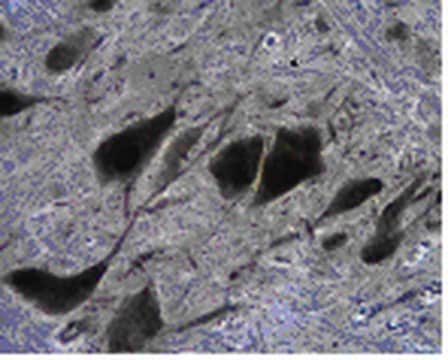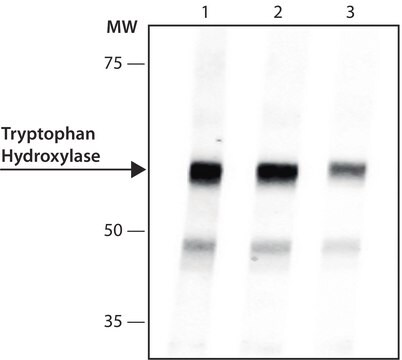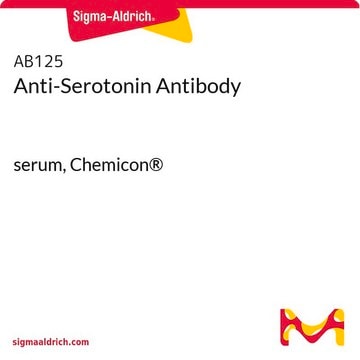Transportation information can be found in Section 14 of the product's (M)SDS.To access the shipping information for this material, use the link on the product detail page for the product.
Kluczowe dokumenty
T0678
Anti-Tryptophan Hydroxylase Antibody
mouse monoclonal, WH-3
Synonim(y):
Anty-TPH
Wybierz wielkość
2240,00 zł
Wybierz wielkość
About This Item
2240,00 zł
Polecane produkty
Nazwa produktu
Monoclonal Anti-Tryptophan Hydroxylase antibody produced in mouse, clone WH-3, ascites fluid
pochodzenie biologiczne
mouse
białko sprzężone
unconjugated
forma przeciwciała
ascites fluid
rodzaj przeciwciała
primary antibodies
klon
WH-3, monoclonal
masa cząsteczkowa
antigen 55 kDa
zawiera
15 mM sodium azide
reaktywność gatunkowa
human, monkey, rabbit, rat
metody
immunohistochemistry: suitable
indirect ELISA: suitable
microarray: suitable
western blot: 1:1,000 using rabbit pineal gland extract
izotyp
IgG3
numer dostępu UniProt
Warunki transportu
dry ice
temp. przechowywania
−20°C
docelowa modyfikacja potranslacyjna
unmodified
informacje o genach
human ... TPH1(7166) , TPH2(121278)
rat ... Tph1(24848) , Tph2(317675)
Opis ogólny
Specyficzność
Immunogen
Zastosowanie
- enzyme-linked immunosorbent assay (ELISA)
- immunohistochemistry
- immunoblot
- immunocytochemistry
Działania biochem./fizjol.
Oświadczenie o zrzeczeniu się odpowiedzialności
Nie możesz znaleźć właściwego produktu?
Wypróbuj nasz Narzędzie selektora produktów.
polecane
Kod klasy składowania
10 - Combustible liquids
Klasa zagrożenia wodnego (WGK)
nwg
Temperatura zapłonu (°F)
Not applicable
Temperatura zapłonu (°C)
Not applicable
Wybierz jedną z najnowszych wersji:
Certyfikaty analizy (CoA)
Nie widzisz odpowiedniej wersji?
Jeśli potrzebujesz konkretnej wersji, możesz wyszukać konkretny certyfikat według numeru partii lub serii.
Masz już ten produkt?
Dokumenty związane z niedawno zakupionymi produktami zostały zamieszczone w Bibliotece dokumentów.
Klienci oglądali również te produkty
-
What is the Department of Transportation shipping information for this product?
1 answer-
Helpful?
-
-
Do you have an immunohistochemistry protocol for use with Product T0678, Monoclonal Anti-Tryptophan Hydroxylase antibody produced in mouse?
1 answer-
Free floating sections (4% paraformaldehyde fixation)1. Incubate 30 minutes at room temperature in 0.3% Triton X-100, 5% normal serum.2. Incubate with the antibody diluted 1:10,000 in PBS, 0.3% Triton X-100, 3.5% normal serum and 0.05% BSA for 36-48 hours.3. Rinse 3 times for 5 minutes each in PBS.4. Add the biotinylated anti-mouse IgG3 diluted in PBS containing 0.3% Triton X-100 and 3.5% normal serum for 1 hour at room temperature.5. Rinse 3 times for 5 minutes each in PBS.6. Process with Avidin Biotin-HRP.7. Complete the reaction with a 2-10 minute incubation in PBS containing 0.05% DAB and 0.015% hydrogen peroxide (H2O2).8. Mount the sections on gel coated slides and air dry.
Helpful?
-
-
Does Product T0678, Monoclonal Anti-Tryptophan Hydroxylase antibody produced in mouse, cross-react with tyrosine or phenylalanine hydroxylases?
1 answer-
This antibody, unlike some other antibodies to tryptophan hydroxylases (WH) in the market, does not cross react with tyrosine hydroxylase (TH) or with phenylalanine hydroxylase (PH). The epitope recognized by the antibody is not located in the Pterin Binding Region, which is homologous among PH, TH and WH. The specificity to WH is confirmed by the single band obtained at the 55KD region, while TH has a higher MW (60-68KD), depending on the submit) and PH has a lower MW. It has also been confirmed by collaborating experts. See Journal of Neuroscience Methods, 114(2), 205-212 (2002).
Helpful?
-
-
Can Product T0678, Monoclonal Anti-Tryptophan Hydroxylase antibody produced in mouse, be used to stain mouse brain sections?
1 answer-
This antibody has been used successfully on mouse brain slices in an immunohistochemical application. The IHC results from an experiment employing T0678 at 1:500 in mouse brain slice staining clearly showed the dorsal nuclear raphe (which are the serotonergic neurons).
Helpful?
-
Active Filters
Nasz zespół naukowców ma doświadczenie we wszystkich obszarach badań, w tym w naukach przyrodniczych, materiałoznawstwie, syntezie chemicznej, chromatografii, analityce i wielu innych dziedzinach.
Skontaktuj się z zespołem ds. pomocy technicznej









